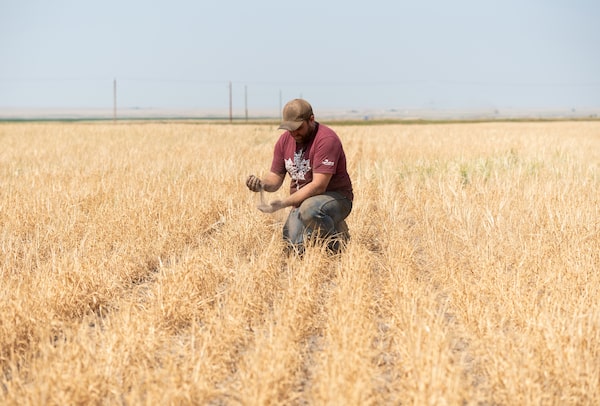
Jake Kirschenman lets dry soil fall through his hands on farmland that is burned as a result of severe drought in Medicine Hat, Alta., on July 21.HARI SINGH/The Globe and Mail
Alberta expects to pay out about $1-billion in insurance this year because of a severe drought that has crippled crops, killed poultry and cut into dairy production across Western Canada and the United States.
Devin Dreeshen, Alberta’s Minister of Agriculture and Forestry, said this year’s crop insurance claims will be comparable to 2002, when farmers and ranchers in Alberta collected about $1-billion after a significant drought. He made his estimate as a number of rural municipalities in Western Canada declared states of emergency in an effort to draw political attention to the deteriorating conditions of fields and pastures.
The dry conditions, which were made worse by a recent heat wave that shattered records and is believed to have contributed to hundreds of B.C. deaths, are also fuelling wildfires in Western Canada in what has already become the most destructive season in recent memory. Experts have said climate change is driving an increase in such extreme conditions.
Dry conditions are not unusual, but the scale of this year’s drought is unique. Roughly 80 per cent of Western Canada’s agriculture land is experiencing drought, which means, for example, as crops fail and pastures wither, there is a shortage of cattle feed across the Prairies. The federal Minister of Agriculture and Agri-Food, Marie-Claude Bibeau, will tour Manitoba’s Interlake region Thursday as governments weigh relief programs.
Mr. Dreeshen said about 75 per cent of farmers in Alberta have insurance through Agricultural Financial Services Corp. It has executed about 300 early assessments and has another 255 scheduled for this week, he said.
“The way that crop expectations and yield forecasts are dropping ... in the next month or so, we’ll probably hit $1-billion of yield loss,” Mr. Dreeshen said in an interview Wednesday. Farmers and ranchers seek early assessments on poor crops because they can then use the surviving plants for livestock feed, salvaging some nutritional value before they deteriorate further.
Trevor Hadwen, an agroclimate specialist at Agri-Food Canada, said large parts of the West are going through a one-in-20-year drought and parts of Manitoba and Saskatchewan are experiencing a one-in-50-year situation.
“To have the entire region – or almost the entire region – in such severe drought is extremely uncommon,” he said. About 25 per cent of Manitoba’s agriculture land is in a one-in-50-year drought, Mr. Hadwen said.
The drought has been building for more than a year. Parts of Western Canada have been dry since last summer and winter was short on snow, Mr. Hadwen noted. Without soil moisture in the spring, farmers and ranchers were counting on seasonal rainfall to keep their crops and pastures healthy.
But Western Canada typically does not receive enough rain in the growing season to get by without support from moisture in the ground, Mr. Hadwen said. The heat wave in June and July amplified problems tied to the dry soil and lack of rain.
Jake Kirschenman farms in Alberta and Saskatchewan and eschews crop insurance. He was fixing his swather in a field of triticale the other day when he dropped a bolt. The crop was ugly, lacking value or hope for a comeback. He was cutting it for salvage, for cattle feed.
The bolt fell in a crack in the Saskatchewan soil. He stuck his hand in the gap, up to his wrist, to retrieve it.
“There was no way I could ever find it,” he said. The crack was too big. “I’ve never seen anything like that before.”
Alberta, Manitoba, Ontario, British Columbia and Saskatchewan have requested support from the federal government through the AgriRecovery framework. Federal and provincial officials are now designing disaster relief programs province-by-province, and Ottawa and the respective provincial capitals will share the tab. Mr. Dreeshen, the provincial Agriculture Minister, noted these funds can help offset the cost of uninsurable added expenses, like temporary fencing around fields so cattle can graze on crops that are not worth harvesting.
Ms. Bibeau, the federal Agriculture Minister, said Ottawa is working with provinces on a number of measures, such as AgriRecovery. “We are working around the clock to turn those around as quickly as possible to help farmers with the extraordinary costs they face,” she said in a statement.
Alberta’s Cypress County on Tuesday declared a state of emergency and made plans to push federal and provincial legislators for relief. Dustin Vossler, a councillor and local farmer, said Cypress County wants the government to ease the guidelines on crop and grass insurance. For example, crop insurance could provide full coverage for fields that will yield just 10 bushels per acre, rather than setting the ceiling at three bushels per acre, Mr. Vossler said.
“In a year like this year, that would be very, very helpful for producers,” Mr. Vossler said, noting his crops are irrigated so he is not in as rough shape as others.
We have a weekly Western Canada newsletter written by our B.C. and Alberta bureau chiefs, providing a comprehensive package of the news you need to know about the region and its place in the issues facing Canada. Sign up today.
 Carrie Tait
Carrie Tait